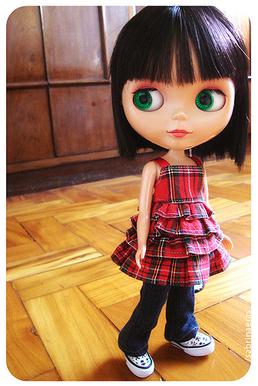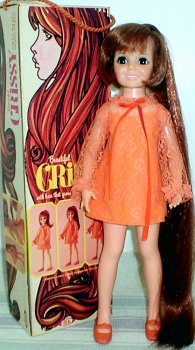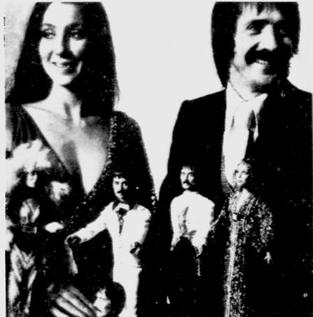
Barbie is a fashion doll created by American businesswoman Ruth Handler, manufactured by American toy and entertainment company Mattel and introduced on March 9, 1959. The toy was based on the German Bild Lilli doll which Handler had purchased while in Europe. The figurehead of an eponymous brand that includes a range of fashion dolls and accessories, Barbie has been an important part of the toy fashion doll market for over six decades. Mattel has sold over a billion Barbie dolls, making it the company's largest and most profitable line. The brand has expanded into a multimedia franchise since 1984, including video games, animated films, television/web series, and a live-action film.

Kenneth Sean "Ken" Carson Jr. is a fashion doll introduced by American toy company Mattel in 1961 as the counterpart of Barbie, who had been introduced two years earlier.

Margaret "Midge" Hadley Sherwood is a doll character in the Barbie line of toys by Mattel that was first released in 1963. She was marketed as Barbie's best friend.

Blythe is a fashion doll, about 28 cm (11 inch) tall, with an oversized head and large eyes that change color with the pull of a string. It was created in 1972 and was initially only sold for one year in the United States by toy company Kenner. In 2001, the Japanese toy company Takara began producing new editions of Blythe dolls. There is a network of hobbyists who customize the doll for resale and create clothing and shoes for Blythe. Enthusiasts share photographs of their work and other types of dolls on the Internet.

Skipper Roberts is a doll created by Mattel in 1964 to be Barbie's young sister. Since 2009, she has a purple streak in her hair and is shown to have a tech-savvy personality. According to her fictional biography, Skipper calls herself a gadget girl who likes computers and trying out the latest technology. In the Barbie films, she likes to work on her photo blog. She had a starring role in the 2023 television film, Barbie: Skipper and the Big Babysitting Adventure.
Since Barbie's introduction as a teenage fashion model in 1959, the doll has been portrayed with many careers. Dolls are sold with sets of clothes and accessories that fit the career being portrayed. For example, the Lifeguard Barbie playset includes a Barbie, an outfit with shoes, a lifeguard chair, a dolphin, and a life preserver, while the Spanish Teacher Barbie includes a Barbie, an outfit with shoes, flashcards, a Spanish quiz, an easel, a notebook, a key chain, and a hairbrush.
Polly Pocket is a toy line of dolls and accessories first founded and designed by Chris Wiggs in 1983 and licensed by Bluebird Toys from 1989 until both entities/properties were acquired by Mattel in 1998.
Chatty Cathy was a pull-string "talking" doll originally created by Ruth and Elliot Handler and manufactured by the Mattel toy company from 1959 to 1965. The doll was first released in stores and appeared in television commercials beginning in 1960, with a suggested retail price of $18.00, though usually priced under $10.00 in catalog advertisements. Chatty Cathy was on the market for six years and was the second most popular doll of the 1960s after Barbie.
Totally Hair Barbie is a fashion doll, in the Barbie line by Mattel, that was released in 1992. The doll's extra-long hair reached all the way to her toes and at the time, she had the longest hair ever for a Barbie doll at 11.5 inches in length. She is notable for being the highest selling Barbie doll in history, having racked up $100 million worldwide in 1992.

Crissy was an American fashion doll with a feature to adjust the length of its hair. Crissy was created in the Ideal Toy Corporation's prototype department in 1968.
Dollikins were dolls manufactured by Uneeda Doll Company, a company founded in 1917 by the Sklarsky family in Brooklyn, New York. Dollikins were marketed as The World's Most Posable Doll. The dolls were manufactured from 1957 to 1980. Originally, Dollikins were designed to compete with similar 18–21 inch sized dolls that were popular through the 1950s and 1960s, such as Madame Alexander's "Cissy", Ideal's "Revlon", American Character's "Toni", Deluxe Reading's "Candy" Horseman's "Sindy". Horseman's "Wonderkin" and Valentine's "Mannikin". The dolls started at 19-20" tall and featured sleepy eyes, although later versions were 12" and 6" without sleepy eyes due to the popularity of the Mattel Barbie Doll which is 11.5 inches and the Topper Dawn doll which was 6 inches. See Facebook by searching, The Dollikin Collective
Dawn dolls are small fashion dolls that were made by Deluxe Reading between 1970 and 1973. They measure 6.5 inches in height and have painted eyes and lips. The girl dolls feature rooted hair and eyelashes. The boy dolls have molded hair.

What's Her Face! was a line of customizable dolls that straddled the line between traditional fashion dolls and creative activity toys. Made by Mattel, the line ran from 2001–2003, and enjoyed only a modest success in a market dominated by Mattel's iconic Barbie and MGA Entertainment's Bratz dolls. Following the discontinuation of the What's Her Face! line, their body molds were used for the Wee 3 Friends line of Barbie-related dolls. Several fashion, wig, and activity packs were also released for the What's Her Face line.

My Scene is an American series of fashion dolls that Mattel released in 2002. They were discontinued in the US in 2008, and worldwide in 2011. Mattel's Barbie character was one of the dolls in the toy line. The My Scene dolls' bodies were slim, similar to earlier Barbie dolls, but their heads were larger. The New York Times described their features as "exaggerated lips and bulging, makeup-caked eyes." My Scene were designed to appeal to the tween market and compete with the Bratz dolls from MGA Entertainment.

The Bild Lilli doll was a West German line of fashion doll launched by Greiner & Hausser GmbH on August 12, 1955 and produced until 1964. Its design was based on the comic-strip character Lilli, created by Reinhard Beuthien for the tabloid newspaper Bild. The doll was made of polystyrene, came in two sizes, and had an available wardrobe of 1950s fashion. The Lilli doll was copied, and altered to some degree, for Mattel upon the direction of that company's co-founder, Ruth Handler. Mattel acquired the rights to Bild Lilli in 1964, and production of the German doll ceased in favor of Mattel's new vinyl doll, which they called Barbie.

The Sonny & Cher dolls were a collection of 12-¼ inch high celebrity doll likenesses of pop rock duo Sonny & Cher. The line was released by Mego Corporation in 1976. The release of these fashion dolls coincided with the popularity of The Sonny & Cher Show prime time variety TV show.
Princess of Power is a toyline created by Mattel. Among others, it features the characters of She-Ra and Catra on planet Etheria. With its launch in 1984, the toyline spawned a variety of products, including three lines of fashion action figures. The Princess of Power logo and characters are currently used by Mattel as part of the Masters of the Universe Classics toyline.
The Barbie Basics is a line of collector's edition Barbie dolls. They were created by Mattel designer Bill Greening and were introduced in late 2009 to be officially released in the spring of 2010.
The Marvelous World of Shani, also known as Shani & Friends or simply Shani, was a fashion doll line manufactured by the American toy company Mattel, Inc. and launched in 1991. The principal designer of the dolls was longtime Mattel toy designer Kitty Black Perkins, also responsible for designing 1980's First Black Barbie doll, and many other African American dolls in the Barbie line.









